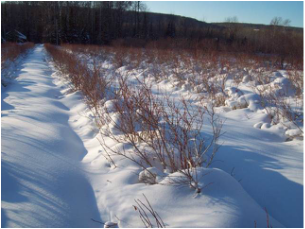
"Winter injury" (cold injury) is generally understood to result from four causal affects:
1.) Ambient cold temperatures that exceed the known hardiness limits for particular temperate zone perennial plant varieties (approximately -25F for most of the blueberry varieties we grow).
2.) Desiccation due to dry soils, cold dry air, and excessive wind exposure.
3.) Widely fluctuating temperatures following a sufficient dormant chill that can cause perennial plants to lose hardiness, e.g sub-zero temps following a prolonged midwinter thaw.
4.) Late freezes after spring bud break or during blossom.
Other than the bloom itself, fruit buds are the plant parts most susceptible to cold injury--especially those buds wintering above the snow line. The tips of canes, the last green growth of the season, are also susceptible to die-back especially when winter comes early or suddenly. Older fruiting canes can also be killed by cold injury--especially following an "open" winter. In the absence of protective snow cover or deep mulch, frost in the ground can cause damage to roots which are needed to support more demanding older canes. The effects of winter injury do not always reveal themselves immediately following the break of dormancy in the Spring. Often the die-back or collapse happens well after bud break, flowering, or even fruit set.
All of this discussion however, does not seem to fully explain what we experienced with the 2015 blueberry crop failure. By my record and recollection, the four causal affects of winter injury described above were not observed in our fields--at least not to any extreme. There were no ambient temperatures that even approached -25F. We tested good soil moisture in the Fall and maintained irrigation schedules to leaf-fall. Snow cover seemed adequate through the colder periods of the winter and we did not experience any frost during the bloom period. Our raspberry field exhibited NO winter injury and fruited well. Tips of blueberry canes exposed above the snowline of some of our more tender varieties, e.g. "Nelson" and "Duke", fruited and did not show any die-back. Blueberry blocks that had been more recently pruned (within the last three years) fruited best. It was older fruiting canes in more neglected blocks that were most severely affected.
Winter 2014-15 undoutedly played its part, but I believe the conditions resulting in the losses experienced in 2015 began with the winter of 2013-14--a winter of excessively heavy snowfall. By February of that winter the snow pack measured nearly four feet deep in our fields. Any cane standing less than vertical became trapped in this mass of snow and was bowed to the ground. An extremely heavy fruit load in 2014 did not allow stiffer older bowed fruiting canes to "bounce back". Although harvest was heavy in 2014, it was difficult to access. Following harvest, older canes in this bowed condition began to die. By spring 2015, these older canes were dead in huge numbers. Those misshapen canes that did survive began to sprout "water shoots" from the tops of their arched shape--new growth that would not fruit that year, but whose leaves formed a canopy of shade over those canes that might have fruited--or that did fruit and couldn't be accessed.
We know that tropism has a large affect on the production of fruit trees. Obtaining consistency in apple production is in part the art of pruning and limb training to balance the vegetative vertical tropism and the fruiting horizontal tropism. What do we know of the effects of tropism on blueberry fruiting? Could it be that these canes that had been deformed by a heavy snow load were now performing abnormally because the effects of tropism?
My strongest suspicion, though I am not a scientist, is that a 1-2 inch diameter hardwood cane can not be doubled over in a bow without some internal cane damage taking place--some slippage between the bark and the cambium layers, or the cambium and the heartwood--or even between the growth rings. Could this have been the beginning of demise?
When I was younger, I had ready answers for those who asked concerning the events affecting our crops. Now with experience, while I may be more knowledgeable, I am less sure. The longer I continue to farm, the more I come to respect the complexity and the mystery of "Mother Nature."


 RSS Feed
RSS Feed
